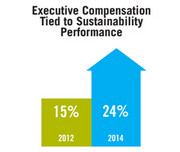 |
| Reviews and Templates for Expression We |
Why Most Companies Don’t Link ESG Performance to Executive Pay

Linking executive pay to corporate environmental, social and governance performance isn’t a new idea but it’s been slow to gain traction.
Some 75 percent of large US companies don’t explicitly link executive compensation and sustainability, according to Ceres’s most recent report, using 2014 data. A Glass Lewis report that reviewed this trend globally (also using 2014 data) found 60 percent of companies don’t provide a link.
The trend is growing, albeit slowly.
The Corporate Knight’s 12th annual Global 100 Most Sustainable Corporations list, published last week, found 87 percent of the Global 100 firms provided a monetary bonus to executives who achieved sustainability targets, up from 85 of last year’s Global 100. This year’s companies that link pay to sustainability — this encompasses environmental and employee-related targets — include BMW, Coca-Cola, Schneider Electric and Adidas.
The growing number shows that companies are increasingly realizing that sustainability impacts the bottom line, says Michael Yow, Corporate Knights director of research.
“The increasing number of cases where executive pay is linked to one or more sustainability-related performance targets is an indication that corporation are coming to the realization that financial performance alone may not enough, that sustainability factors may have a material impact, direct or indirect on the company’s prosperity over the long-term,” Yow says.
Both the Glass Lewis and Ceres reports also found over time more companies are linking compensation and sustainability progress. In 2014, Glass Lewis found about 40 percent of all global companies reviewed provided a link, up from 29 percent in 2010. Among US companies, Ceres found the number of companies linking executive pay to sustainability grew from 15 percent in 2012 to 24 percent in 2014.
“The sectors leading on this issue tend to be heavy industries (utilities, materials etc.) where sustainability issues such as climate change, water availability, pollution and safety are long understood as having material impacts on the company and in many cases are regulated,” says Ceres’ Veena Ramani senior director, corporate programs.
The Ceres report separated companies into one of four performance tiers. The 7 percent (40 companies) in Tiers 1 and 2 make explicit links between compensation practices and publicly disclosed sustainability targets. Only the 3 percent (19 companies) performing in Tier 1 are linking executive compensation to sustainability performance targets that go beyond goals driven by required compliance with laws and regulations.
Examples of leading companies include:
- Alcoa ties 20 percent of executive cash compensation to ESG stewardship, including voluntary GHG reductions, energy efficiency and diversity goals.
- Exelon jumped from Tier 4 to Tier 1 with a “long-term performance share award” that rewards executives for meeting non-financial performance goals, including safety targets, GHG emissions reduction targets and goals engaging stakeholders to help shape the company’s public policy positions.
- Xcel Energy ties executive compensation to specific performance measures, including environmental leadership. Most notably, Xcel links compensation to goals achieved in demand-side management, or reductions in energy consumption by its customers.
“We find that the executive compensation-sustainability link is a great indicator of how seriously a company’s leadership takes sustainability — and the extent to which sustainability performance is genuinely prioritized and integrated within the enterprise,” Ramani says. “At the end of the day, everyone is motivated by their paychecks, and where a company’s leadership is incentivized in this way for environmental and social performance, it sets a clear tone from the top that permeates through the organization.”
So why are the majority of firms still not making this link? Ramani attributes this to three factors.
“To a large extent, sustainability is still considered and addressed in a silo in most organizations,” Ramani says. “As a result, while there may be one executive who is responsible for sustainability performance, it is still not considered a cross-organizational or management priority.”
Second: ESG performance is largely consider a middle management responsibility, she says. And finally there’s the issue of transparency. “Some organizations note that they are taking sustainability seriously, including through compensation, but provide no details on the issues prioritized, weight assigned to sustainability factors and where this is applied,” such as short- versus long-term compensation, Ramani says. Only 7 percent of the companies Ceres assessed explicitly linked compensation and publically disclosed sustainability targets.
But as more companies recognize the link between ESG performance and risk management — and as environmental regulations increasingly come into play — it will be interesting to see if the ESG-executive pay link continues to grow.
|
|
|
|
Copyright 2011 Energy and Technical Services Ltd. All Rights Reserved. Energyts.com |